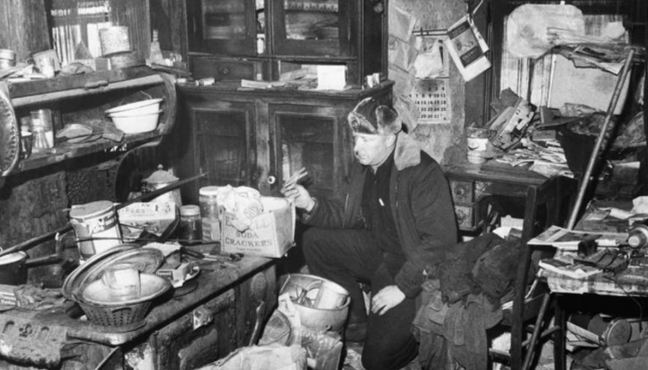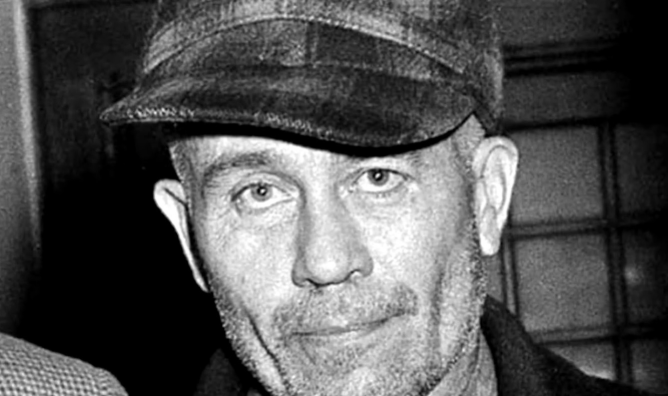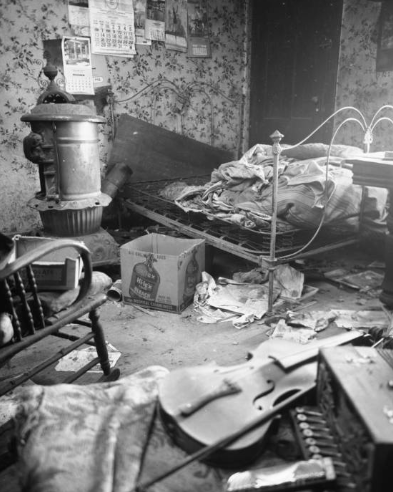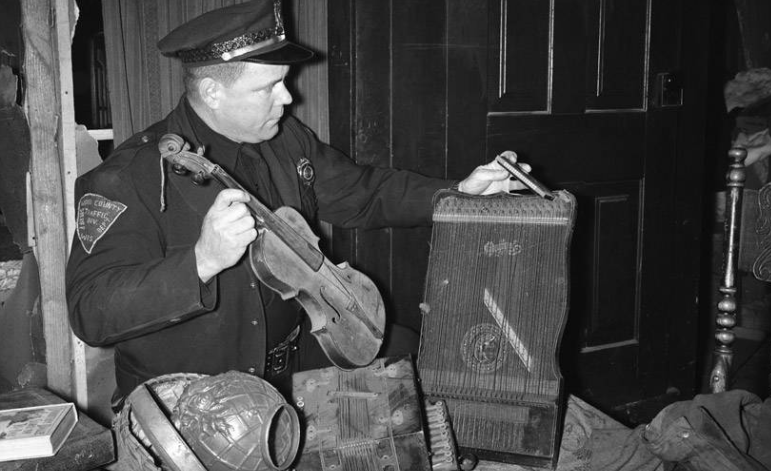The Macabre Story Of Ed Gein, The Serial Killer Who Used Human Body Parts To Make Furniture

The Ed Gein Case: The Ghoul of Plainfield and the Birth of Modern Horror
In the quiet, rural town of Plainfield, Wisconsin, during the 1950s, a horrifying series of discoveries shattered the peace and shocked the world. At the center of it all was a seemingly unremarkable man named Edward Theodore Gein. Known to neighbors as a shy, reclusive, and slightly odd handyman, Ed Gein would become infamous as one of the most grotesque criminals in American history.
Though Gein was ultimately convicted of only two murders, the grisly details of his crimes and his bizarre obsession with death, corpses, and human anatomy had a profound and lasting impact—not only on law enforcement and psychological profiling, but also on American pop culture. Gein’s story inspired some of the most iconic villains in horror history, including Norman Bates in Psycho, Leatherface in The Texas Chainsaw Massacre, and Buffalo Bill in The Silence of the Lambs.

Early Life and Upbringing
Ed Gein was born on August 27, 1906, in La Crosse County, Wisconsin. He was the second son of George and Augusta Gein. His father was an alcoholic who struggled to hold steady employment, while his mother, Augusta, was a domineering, fanatically religious woman who preached the inherent sinfulness of the world, especially the evil of women and sex.
Augusta moved the family to a remote farm in Plainfield, where she kept her two sons—Henry and Ed—isolated from the outside world. She taught them that all women (except herself) were instruments of the devil and instilled a fear of sexuality, social interaction, and independence. Despite this abuse, Ed idolized his mother and remained deeply attached to her throughout his life.
When George Gein died in 1940, the family fell further into isolation. In 1944, Ed’s older brother Henry died under suspicious circumstances during a fire on the property. Though Ed reported the incident as an accident, later speculation suggested that Henry may have questioned Augusta’s influence over Ed and was possibly killed by his brother. However, no charges were filed.
Two years later, Augusta suffered a series of strokes and died in December 1945. Her death devastated Ed. Left completely alone on the family farm, he sank into a state of psychotic detachment from reality.
Descent into Madness
After his mother’s death, Ed Gein sealed off the rooms she had used, including the parlor and her bedroom, preserving them as shrines. He lived in a small, unheated section of the house and began spending increasing amounts of time reading pulp horror novels, Nazi medical texts, and books on anatomy, cannibalism, and the occult.
Over time, Gein developed a morbid fascination with the female body and an intense desire to become a woman—believing this could bring him closer to his beloved mother. This obsession led him to commit acts that were almost incomprehensible in their grotesqueness.
Grave Robbing and Trophy Making

Between 1947 and 1957, Gein made numerous nocturnal trips to local cemeteries, where he would exhume recently buried female corpses—especially middle-aged women who resembled his mother. He would bring the bodies back to his farmhouse and use them for various macabre purposes.
Gein flayed the corpses, tanned the skin, and crafted a grotesque collection of human trophies. Police would later discover:
-
Bowls made from human skulls
-
Chairs and lampshades upholstered with human skin
-
A belt made of nipples
-
A box of preserved vulvas
-
Masks made from human faces
-
A “woman suit” fashioned from the skin of multiple bodies, which Gein admitted to wearing
He claimed he wore the skin to “feel like a woman,” and to pretend to be his mother. These acts were not driven purely by sadism or lust, but by a deep psychological disturbance rooted in guilt, grief, and sexual confusion.
The Murders
Though Gein’s grave robbing was nightmarish enough, his crimes escalated to murder. In 1954, Mary Hogan, a local tavern owner, disappeared without a trace. Her case went cold—until 1957, when another woman went missing.
On November 16, 1957, Bernice Worden, the owner of a hardware store in Plainfield, vanished. Her son, a deputy sheriff, discovered the store was closed and the cash register was missing. The last sales receipt listed Ed Gein as a customer.
Police went to Gein’s farm to question him—and what they found there would shock even the most seasoned investigators.
The Farmhouse of Horrors
Inside the dilapidated farmhouse, police discovered an unimaginable scene. The house was filthy, cluttered, and dark. In the kitchen shed, they made the first horrifying discovery: the decapitated, gutted body of Bernice Worden hanging upside down from the rafters, like a butchered deer. She had been shot and mutilated post-mortem.
Further searches of the home revealed Mary Hogan’s face, preserved like a mask, along with her skull. Investigators also found human organs in jars, furniture covered in human skin, and Gein’s gruesome “woman suit.” Altogether, remains from at least 10 different women were found in his home.
Despite this, Gein was only charged with the murders of Worden and Hogan—since the other remains were traced to already-dead women exhumed from graves.
Arrest, Trial, and Commitment
Gein was arrested on November 17, 1957. During questioning, he was calm and cooperative, confessing to the murders and to numerous grave robberies. He showed no remorse and often spoke about his crimes in a detached, matter-of-fact tone.
A psychological evaluation found Gein legally insane. He was committed to the Central State Hospital for the Criminally Insane (later moved to Mendota Mental Health Institute), where he would remain for the rest of his life. In 1968, he was found mentally competent to stand trial and was convicted of the murder of Bernice Worden, but due to his insanity, he remained institutionalized.
Ed Gein died of respiratory failure on July 26, 1984, at the age of 77.
Psychological Profile
Experts agree that Ed Gein suffered from severe mental illness, likely including schizophrenia and psychotic delusions. His attachment to his mother, known as “maternal enmeshment,” and the subsequent trauma of her death played a major role in the development of his disorders.
He exhibited signs of dissociative identity disorder, gender dysphoria, necrophilia (though he denied sexual intercourse with corpses), and obsessive-compulsive behaviors. Gein’s crimes were less about sexual gratification and more about a distorted desire to resurrect his mother or transform into her.
The “woman suit” he created was not only a grotesque expression of this desire, but also a manifestation of his inability to process grief and identity. His crimes are often cited in forensic psychology courses as examples of the profound impact of early childhood trauma and isolation.

Cultural Impact and Legacy
Though his crimes were committed in a remote town by a seemingly obscure man, Ed Gein became one of the most influential figures in American criminal lore. His story inspired countless books, movies, and discussions on the nature of madness and evil.
Notable characters inspired by Gein include:
-
Norman Bates in Alfred Hitchcock’s Psycho (1960), based on Robert Bloch’s novel. Like Gein, Bates was a solitary man dominated by a dead mother.
-
Leatherface in The Texas Chainsaw Massacre (1974), who wore a mask made of human skin and lived in a farmhouse filled with human remains.
-
Buffalo Bill in The Silence of the Lambs (1991), who skinned his female victims to create a suit to “transform” himself.
Gein’s crimes also influenced the development of the “killer with a sick mother fixation” trope in horror and psychological thrillers. The fusion of true crime and horror fiction found a powerful symbol in Gein—the ordinary man capable of unspeakable evil, hidden in plain sight.
Aftermath and Public Fascination
Following Gein’s arrest, his farm became a macabre tourist attraction. People traveled from across the country to gawk at the “House of Horrors.” Eventually, the property was set to be auctioned off, but just before the sale, the house mysteriously burned down. Arson was suspected but never confirmed.
The car Gein used to haul bodies was later exhibited at a carnival, drawing thousands of visitors. Public fascination with his story has remained strong for decades, reflecting a morbid curiosity with the psychology of evil and the boundary between sanity and madness.
Conclusion
The Ed Gein case is one of the most disturbing true crime stories in history—not because of the number of victims, but because of the grotesque and surreal nature of his actions. His descent into madness, fueled by childhood trauma, social isolation, and psychological illness, paints a tragic and terrifying portrait of what can happen when reality fractures beyond repair.
Gein’s legacy is a complex mixture of horror, psychological study, and cultural symbolism. He stands not only as a case study for criminologists and psychologists but also as a cautionary figure about the dark corners of the human mind. Decades later, his story continues to haunt the American consciousness—a chilling reminder that monsters can wear the most human of faces.





